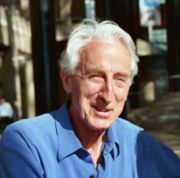
Martin Gutzwiller
Encyclopedia

Physicist
A physicist is a scientist who studies or practices physics. Physicists study a wide range of physical phenomena in many branches of physics spanning all length scales: from sub-atomic particles of which all ordinary matter is made to the behavior of the material Universe as a whole...
. He is known for the invention of the variational wave-function describing electron
Electron
The electron is a subatomic particle with a negative elementary electric charge. It has no known components or substructure; in other words, it is generally thought to be an elementary particle. An electron has a mass that is approximately 1/1836 that of the proton...
s with strong localized interactions (Gutzwiller approximation), for the first investigation of relations between classical and quantum mechanics in chaotic systems (quantum chaos
Quantum chaos
Quantum chaos is a branch of physics which studies how chaotic classical dynamical systems can be described in terms of quantum theory. The primary question that quantum chaos seeks to answer is, "What is the relationship between quantum mechanics and classical chaos?" The correspondence principle...
), as well as new solutions to mathematical problems in field theory, wave propagation, crystal physics, quantum and celestial mechanics.
Gutzwiller, born and raised in Switzerland
Switzerland
Switzerland name of one of the Swiss cantons. ; ; ; or ), in its full name the Swiss Confederation , is a federal republic consisting of 26 cantons, with Bern as the seat of the federal authorities. The country is situated in Western Europe,Or Central Europe depending on the definition....
, initially studied quantum physics under Wolfgang Pauli
Wolfgang Pauli
Wolfgang Ernst Pauli was an Austrian theoretical physicist and one of the pioneers of quantum physics. In 1945, after being nominated by Albert Einstein, he received the Nobel Prize in Physics for his "decisive contribution through his discovery of a new law of Nature, the exclusion principle or...
at the Eidgenössische Technische Hochschule (ETH, Zurich) up to the Diploma degree in 1950. He then went to Kansas State University and obtained a doctorate degree with Max Dresden. He worked in microwave engineering for the BBC, in geophysics for Shell Oil, and eventually for IBM Research in Switzerland, New York City, and Yorktown Heights, until his retirement in 1993. He is currently adjunct professor at Yale University
Yale University
Yale University is a private, Ivy League university located in New Haven, Connecticut, United States. Founded in 1701 in the Colony of Connecticut, the university is the third-oldest institution of higher education in the United States...
. Other teaching positions include Columbia University, ETH Zurich, Paris-Orsay, and Stockholm.
Book:
- Chaos in Classical and Quantum Mechanics, 1990
Honors include:
- Member of the National Academies of Science (1992)
- Fellow of the American Physical Society
- 1993 Dannie Heineman Prize for Mathematical PhysicsDannie Heineman Prize for Mathematical PhysicsDannie Heineman Prize for Mathematical Physics is an award given each year since 1959 jointly by the American Physical Society and American Institute of Physics. It is established by the Heineman Foundation in honour of Dannie Heineman...
(American Physical SocietyAmerican Physical SocietyThe American Physical Society is the world's second largest organization of physicists, behind the Deutsche Physikalische Gesellschaft. The Society publishes more than a dozen scientific journals, including the world renowned Physical Review and Physical Review Letters, and organizes more than 20...
, American Institute of PhysicsAmerican Institute of PhysicsThe American Institute of Physics promotes science, the profession of physics, publishes physics journals, and produces publications for scientific and engineering societies. The AIP is made up of various member societies...
) - 2003 Max-Planck medal (German Physical Society)

